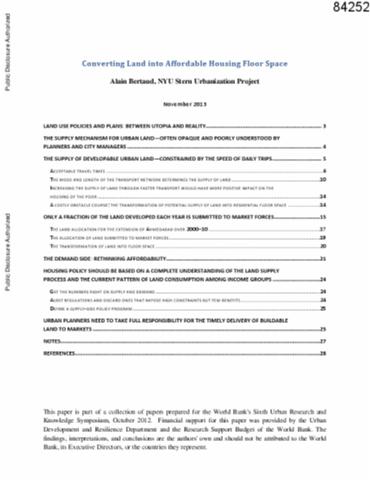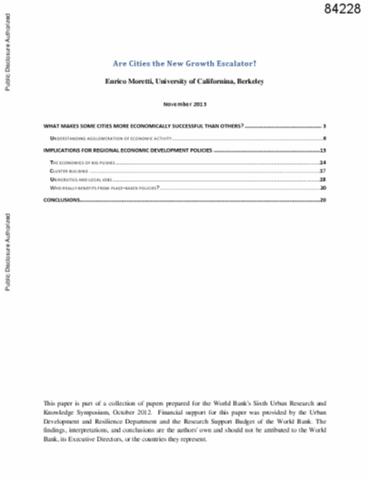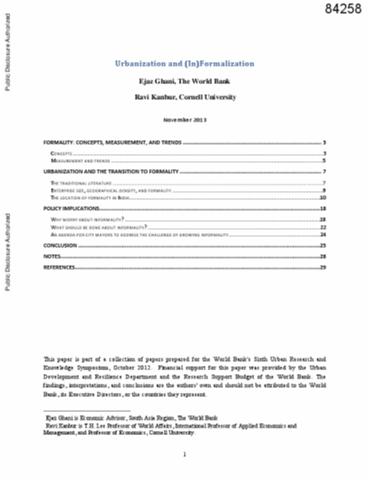The World Bank is a vital source of financial and technical assistance to developing countries around the world. We are not a bank in the ordinary sense but a unique partnership to reduce poverty and support development. The World Bank Group has two ambitious goals: End extreme poverty within a generation and boost shared prosperity.
- To end extreme poverty, the Bank's goal is to decrease the percentage of people living on less than $1.25 a day to no more than 3% by 2030.
- To promote shared prosperity, the goal is to promote income growth of the bottom 40% of the population in each country.
The World Bank Group comprises five institutions managed by their member countries.
The World Bank Group and Land: Working to protect the rights of existing land users and to help secure benefits for smallholder farmers
The World Bank (IBRD and IDA) interacts primarily with governments to increase agricultural productivity, strengthen land tenure policies and improve land governance. More than 90% of the World Bank’s agriculture portfolio focuses on the productivity and access to markets by small holder farmers. Ten percent of our projects focus on the governance of land tenure.
Similarly, investments by the International Finance Corporation (IFC), the World Bank Group’s private sector arm, including those in larger scale enterprises, overwhelmingly support smallholder farmers through improved access to finance, inputs and markets, and as direct suppliers. IFC invests in environmentally and socially sustainable private enterprises in all parts of the value chain (inputs such as irrigation and fertilizers, primary production, processing, transport and storage, traders, and risk management facilities including weather/crop insurance, warehouse financing, etc
For more information, visit the World Bank Group and land and food security (https://www.worldbank.org/en/topic/agriculture/brief/land-and-food-security1
Resources
Displaying 2101 - 2105 of 4907Converting Land into Affordable Housing Floor Space
Cities emerge from the spatial concentration of people and economic activities. But spatial concentration is not enough; the economic viability of cities depends on people, ideas, and goods to move rapidly across the urban area. This constant movement within dense cities creates wealth but also various degrees of unpleasantness and misery that economists call negative externalities, such as congestion, pollution, and environmental degradation.
Are Cities the New Growth Escalator?
Urban areas tend to have much more productive labor and higher salaries than rural areas, and there are vast differences across urban areas. Areas with high salaries and high productivity tend to have employers that invest in much more research and development than areas with low salaries and low productivity. This paper addresses two questions. First, it discusses the causes of these vast geographical differences in wages, human capital, and innovation. The second part of the paper discusses regional economic development policies.
Urbanization and (In)Formalization
Inexorable urbanization and formalization have been the expectations in development discourse. Indeed, measures of urbanization and formalization have been provided and used as indicators of development. But while urbanization has proceeded apace in developing countries, formalization has slowed significantly over the past quarter century. These disconnect raises questions for development analysis and development policy. Why did one expect urbanization and formalization to go together in the first place?
Women’s Legal Rights over 50 Years : What Is the Impact of Reform?
This study uses a newly compiled database of women's property rights and legal capacity covering 100 countries over 50 years to test for the impact of legal reforms on employment, health, and education outcomes for women and girls. The database demonstrates gender gaps in the ability to access and own property, sign legal documents in one's own name, and have equality or non-discrimination as a guiding principle of the country's constitution. In the initial period, 75 countries had gender gaps in at least one of these areas and often multiple ones.
The Golden Quadrilateral Highway Project and Urban/Rural Manufacturing in India
This study investigates the impact of the Golden Quadrilateral highway project on the urban and rural growth of Indian manufacturing. The Golden Quadrilateral project upgraded the quality and width of 5,846 km of roads in India. The study uses a difference-in-difference estimation strategy to compare non-nodal districts based on their distance from the highway system. For the organized portion of the manufacturing sector, the Golden Quadrilateral project led to improvements in both urban and rural areas of non-nodal districts located 0-10 km from the Golden Quadrilateral.









